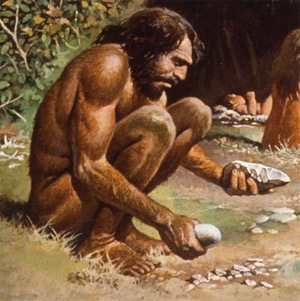
Monday, May 21, 2012
HOMO SAPIENS
During the climatic change of 200,000 years ago Homo Sapiens had evolved. This species were hunter- gatherers and were able to adapt to the changing environment around them. Anatomically speaking Homo Sapiens are very similar to modern Homo Sapien Sapiens (modern man). Their skeletons were of a lighter build than previous human species. The brain size is very large and can vary depending on population and gender. The skull evolved as modern man evolved and became thin-walled, high vaulted with a flat and near vertical forehead. The brow ridge is much smaller and pronounced than previous species and the jaws are less developed with smaller teeth. Evidence shows that we most likely evolved from Homo Heidelbergensis and our closest extinct ancestor is Homo Neanderthal. Homo Sapiens not only made stone tools they refined and specialized them. They created tools that could be used for a variety of different tasks like fishhooks, harpoons, bows and arrows, spear throwers and sewing needles. For millions of years the species Homo spent much of their time hunting and gathering food. But within in the last 12,000 years Homo Sapiens transitioned into producing food and changing the environment. Prehistoric humans discovered they could control the growth and breeding of certain species of plants and animals. This led ultimately to farming and herding. AS agriculture grew so did villages, then towns and finally cities. And thus the human race as we know it was born.
https://humanorigins.si.edu/evidence/human-fossils/species/homo-sapiens
https://humanorigins.si.edu/evidence/human-fossils/species/homo-sapiens
HOMO HEIDELBERGENSIS
About 700,000 to 200,000 yea
Lived in Europe,possibly Asia,africa
Large brain case an extremely large brow ridge. A flatter face. It was the first early spices to live in cold climate short wide bodies better for conservering heat, they controlled fire used wooden spears, hunted large animals, first to build shelters
First discoverd in 1908
Males 5ft 9in and 136lbs
Females5ft 2in and112lbs
http://humanorigins.si.edu/evidence/human-fossils/species/homo-heidelbergensis
Lived in Europe,possibly Asia,africa
Large brain case an extremely large brow ridge. A flatter face. It was the first early spices to live in cold climate short wide bodies better for conservering heat, they controlled fire used wooden spears, hunted large animals, first to build shelters
First discoverd in 1908
Males 5ft 9in and 136lbs
Females5ft 2in and112lbs
http://humanorigins.si.edu/evidence/human-fossils/species/homo-heidelbergensis
HOMO NEANDERTHAL
Lived in Europe and Asia about 200,000 to 28,000 years ago. Homo Neanderthal had angled cheek bones with a protruding jaw, and a heavily built body. Neanderthals stood about 1.6 meters high. Their noses were large and flat for warming cold air and acting as a humidifier. Their brains were as large as ours, but compared to body structure were bigger. Their bodies were short and stocky for keeping in warmth during the Ice Age in which they lived. Evidence shows that Homo Neanderthal controlled fire, lived in shelters and used sophisticated tools (Mousterian Tool Industry). There is also evidence to show that the Neanderthals were the first species of human to bury their dead and mark the grave sites the oldest burial site is approximately 100,000 years old. It is suggested that the Neanderthals made and wore clothing. They also hunted big game and ate plants. The Neanderthals left no genetic legacy to moder humans or Homo Sapien Sapiens and there is no genetic exchange with the Homo Sapiens. The Neanderthals had some form of spoken language. While Homo Neanderthal was realitively advanced the species led a difficult and scarring existence.
information taken from:
http://humanorigins.si.edu/evidence/human-fossils/species/homo-neanderthalensis
http://archaeologyinfo.com/homo-neanderthalensis/
http://www.handprint.com/LS/ANC/hfs9.html
https://www.msu.edu/~heslipst/contents/ANP440/neanderthalensis.htm
information taken from:
http://humanorigins.si.edu/evidence/human-fossils/species/homo-neanderthalensis
http://archaeologyinfo.com/homo-neanderthalensis/
http://www.handprint.com/LS/ANC/hfs9.html
https://www.msu.edu/~heslipst/contents/ANP440/neanderthalensis.htm
Sunday, May 20, 2012
Friday, May 18, 2012
HOMO ERECTUS
Homo Erectus lived approximately 1.89 to 143,000 years ago, in Northern, Eastern and Southern Africa as well as Western and Eastern Asia.
Also known as Homo Ergaster, a specimen found has features that include:
information taken from: http://archaeologyinfo.com/links/
Also known as Homo Ergaster, a specimen found has features that include:
- very thick cranial bones
- reduced development in the frontal and parietal lobes of the brain
- bamboo tools were found near the specimen
information taken from: http://archaeologyinfo.com/links/
Thursday, May 17, 2012
THE ASCENT OF MAN TIMELINE
Starting with Homo Erectus through Homo Sapiens, we are going to lead you down the path to Modern Man.
Subscribe to:
Comments (Atom)



